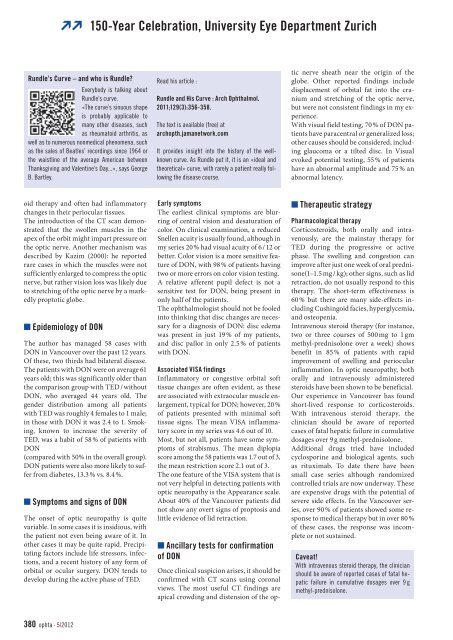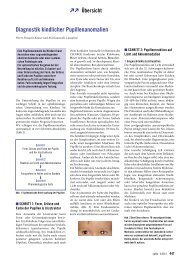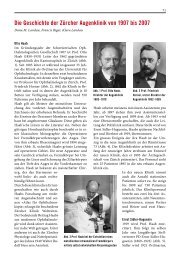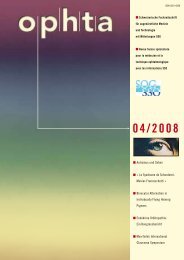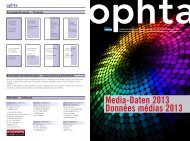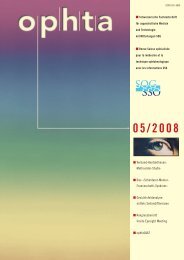Ausgabe 5/2012 - ophta
Ausgabe 5/2012 - ophta
Ausgabe 5/2012 - ophta
Erfolgreiche ePaper selbst erstellen
Machen Sie aus Ihren PDF Publikationen ein blätterbares Flipbook mit unserer einzigartigen Google optimierten e-Paper Software.
150-Year Celebration, University Eye Department ZurichRundle’s Curve – and who is Rundle?Everybody is talking aboutRundle’s curve.«The curve’s sinuous shapeis probably applicable tomany other diseases, suchas rheumatoid arthritis, aswell as to numerous nonmedical phenomena, suchas the sales of Beatles’ recordings since 1964 orthe waistline of the average American betweenThanksgiving and Valentine’s Day...», says GeorgeB. Bartley.Read his article :Rundle and His Curve : Arch Ophthalmol.2011;129(3):356-358.The text is available (free) atarchopth.jamanetwork.comIt provides insight into the history of the wellknowncurve. As Rundle put it, it is an «ideal andtheoretical» curve, with rarely a patient really followingthe disease course.Once clinical suspicion arises, it should beconfirmed with CT scans using coronalviews. The most useful CT findings areapical crowding and distension of the opticnerve sheath near the origin of theglobe. Other reported findings includedisplacement of orbital fat into the craniumand stretching of the optic nerve,but were not consistent findings in my experience.With visual field testing, 70 % of DON patientshave paracentral or generalized loss;other causes should be considered, includingglaucoma or a tilted disc. In Visualevoked potential testing, 55 % of patientshave an abnormal amplitude and 75 % anabnormal latency.oid therapy and often had inflammatorychanges in their periocular tissues.The introduction of the CT scan demonstratedthat the swollen muscles in theapex of the orbit might impart pressure onthe optic nerve. Another mechanism wasdescribed by Kazim (2000): he reportedrare cases in which the muscles were notsufficiently enlarged to compress the opticnerve, but rather vision loss was likely dueto stretching of the optic nerve by a markedlyproptotic globe.■ Epidemiology of DONThe author has managed 58 cases withDON in Vancouver over the past 12 years.Of these, two thirds had bilateral disease.The patients with DON were on average 61years old; this was significantly older thanthe comparison group with TED / withoutDON, who averaged 44 years old. Thegender distribution among all patientswith TED was roughly 4 females to 1 male;in those with DON it was 2.4 to 1. Smoking,known to increase the severity ofTED, was a habit of 58 % of patients withDON(compared with 50% in the overall group).DON patients were also more likely to sufferfrom diabetes, 13.3 % vs. 8.4 %.■ Symptoms and signs of DONThe onset of optic neuropathy is quitevariable. In some cases it is insidious, withthe patient not even being aware of it. Inother cases it may be quite rapid. Precipitatingfactors include life stressors, infections,and a recent history of any form oforbital or ocular surgery. DON tends todevelop during the active phase of TED.Early symptomsThe earliest clinical symptoms are blurringof central vision and desaturation ofcolor. On clinical examination, a reducedSnellen acuity is usually found, although inmy series 20 % had visual acuity of 6 / 12 orbetter. Color vision is a more sensitive featureof DON, with 98 % of patients havingtwo or more errors on color vision testing.A relative afferent pupil defect is not asensitive test for DON, being present inonly half of the patients.The ophthalmologist should not be fooledinto thinking that disc changes are necessaryfor a diagnosis of DON: disc edemawas present in just 19 % of my patients,and disc pallor in only 2.5 % of patientswith DON.Associated VISA findingsInflammatory or congestive orbital softtissue changes are often evident, as theseare associated with extraocular muscle enlargement,typical for DON; however, 20 %of patients presented with minimal softtissue signs. The mean VISA inflammatoryscore in my series was 4.6 out of 10.Most, but not all, patients have some symptomsof strabismus. The mean diplopiascore among the 58 patients was 1.7 out of 3,the mean restriction score 2.1 out of 3.The one feature of the VISA system that isnot very helpful in detecting patients withoptic neuropathy is the Appearance scale.About 40% of the Vancouver patients didnot show any overt signs of proptosis andlittle evidence of lid retraction.■ Ancillary tests for confirmationof DON■ Therapeutic strategyPharmacological therapyCorticosteroids, both orally and intravenously,are the mainstay therapy forTED during the progressive or activephase. The swelling and congestion canimprove after just one week of oral prednisone(1–1.5mg / kg); other signs, such as lidretraction, do not usually respond to thistherapy. The shortterm effectiveness is60 % but there are many sideeffects includingCushingoid facies, hyperglycemia,and osteopenia.Intravenous steroid therapy (for instance,two or three courses of 500 mg to 1 gmmethylprednisolone over a week) showsbenefit in 85 % of patients with rapidimprovement of swelling and periocularinflammation. In optic neuropathy, bothorally and intravenously administeredsteroids have been shown to be beneficial.Our experience in Vancouver has foundshortlived response to corticosteroids.With intravenous steroid therapy, theclinician should be aware of reportedcases of fatal hepatic failure in cumulativedosages over 9 g methylprednisolone.Additional drugs tried have includedcyclosporine and biological agents, suchas rituximab. To date there have beensmall case series although randomizedcontrolled trials are now underway. Theseare expensive drugs with the potential ofsevere side effects. In the Vancouver series,over 90 % of patients showed some responseto medical therapy but in over 80 %of these cases, the response was incompleteor not sustained.Caveat!With intravenous steroid therapy, the clinicianshould be aware of reported cases of fatal hepaticfailure in cumulative dosages over 9 gmethyl-prednisolone.380 <strong>ophta</strong> • 5|<strong>2012</strong>


